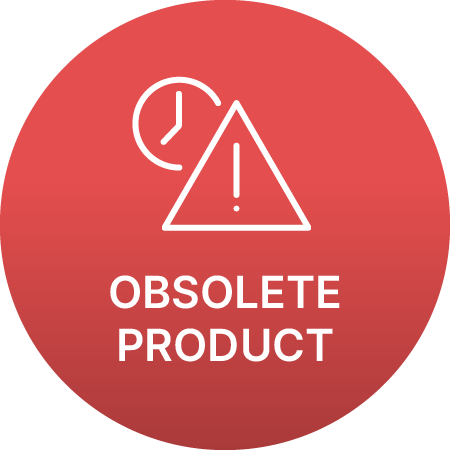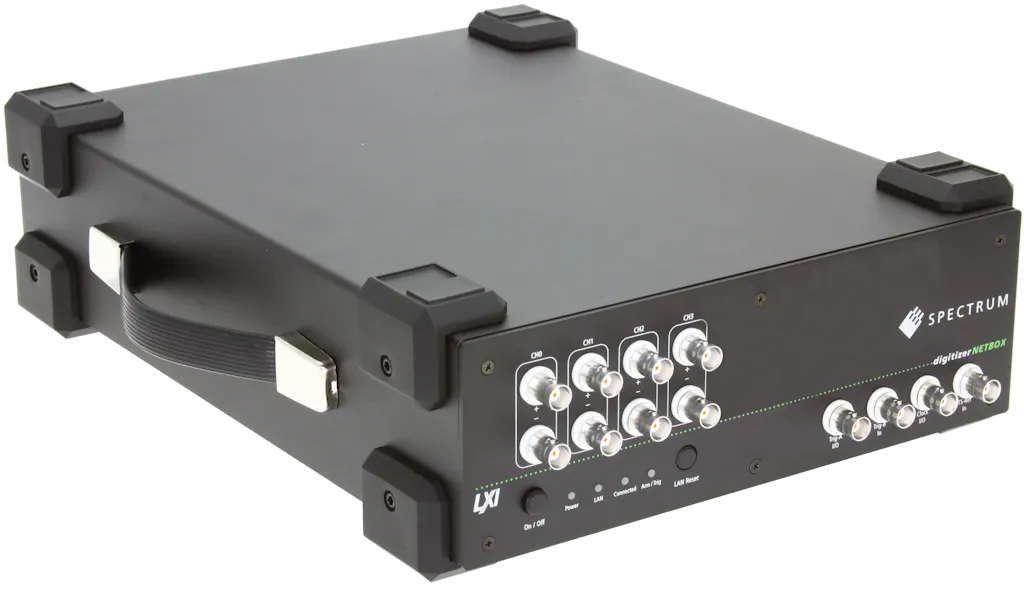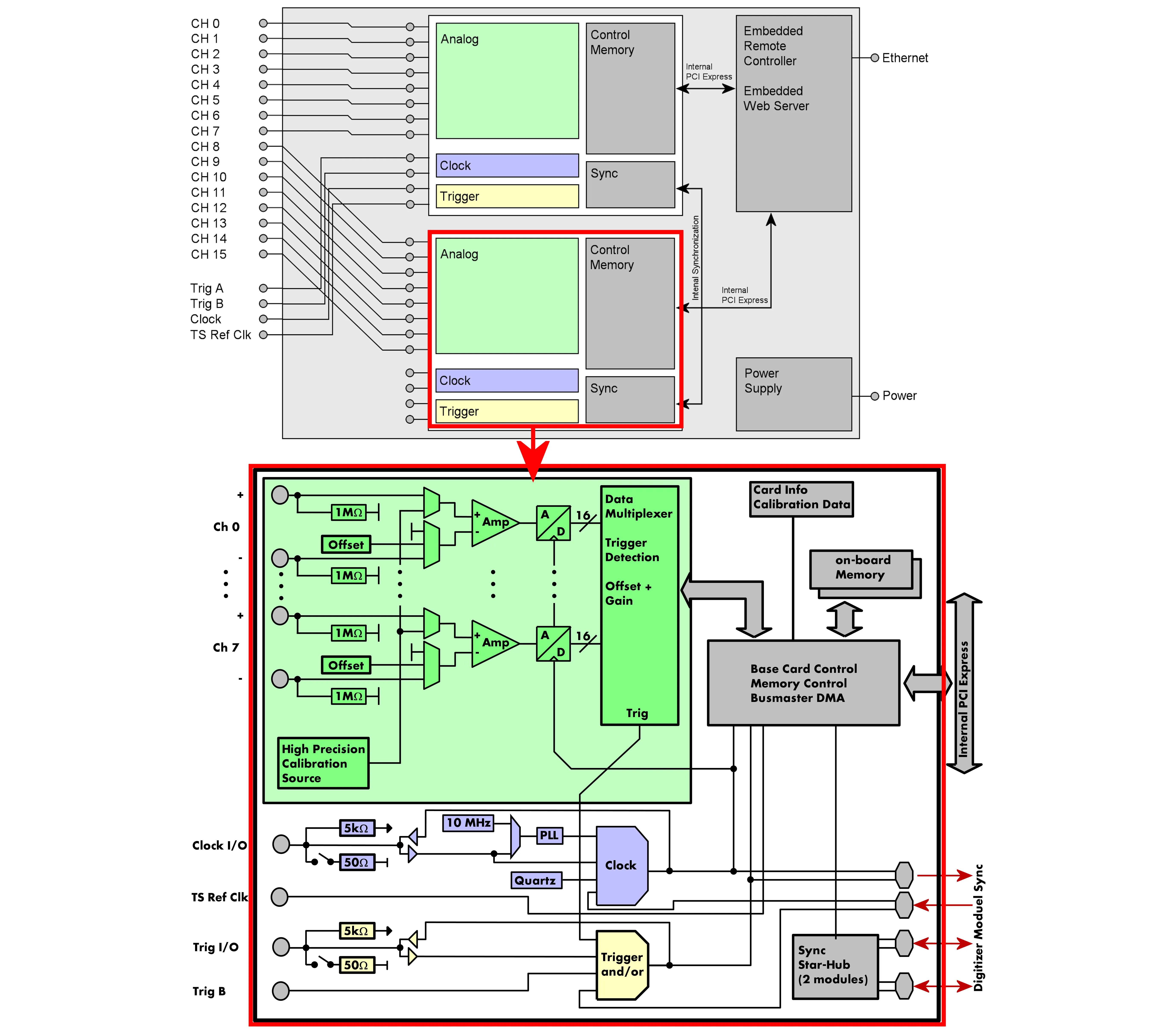THIS PRODUCT IS OBSOLETE. Show more about end-life-products policy.
Recommended product:
Product:
DN2.465-04
16 bit multi-purpose digitizer
Description:
The digitizerNETBOX DN2.46x series allows recording of one, two, four, eight or 16 synchronous channels with sampling rates of 200 kS/s up to 3 MS/s. These products offer outstanding A/D features both in resolution and speed as a remote instrument. The powerful A/D amplifier section offers 8 different input ranges, programmable offset and a software switching from single-ended to differential inputs without decreasing the number of channels.
Facts & Features:
- 3 MS/s on 4 channels
- 4 single-ended inputs
- 4 true differential inputs
- Single-ended or differential inputs by software
- Separate 16 bit ADC and amplifier per channel
- Simultaneous sampling on all channels
- 8 input ranges: +/-50 mV up to +/-10
- Programmable input offset of +/-5 V
- Window, pulse width, re-arm, spike, OR/AND trigger
- ENOB up to 15.0 Bit
- Complete calibration circuit integrated
- GBit Ethernet/LXI compatible instrument
- Easy connectivity with BNC/SMA connections
- SBench 6 Professional included
- Direct remote access from Workstations or Laptops
- Simple integration into the factory LAN
Product-Video:
Application examples:
- Mobile and/or shared data acquisition
- Remote controlled digitizer at experiment
- Component of LXI test system

The ABA mode combines slow continuous data recording with fast acquisition on trigger events. The ABA mode works like a slow data logger combined with a fast digitizer. The exact position of the trigger events is stored as timestamps in an extra memory.
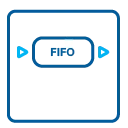
FIFO mode
The FIFO mode is designed for continuous data transfer between the digitizerNETBOX and the host PC. The transfer speed is depending on the Ethernet connection between box and host and is in the region of 40 MB/s to 60 MB/s. The control of the data stream is done automatically by the driver on interrupt request. The complete installed on-board memory is used for buffer data, making the continuous streaming extremely reliable.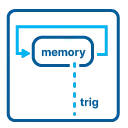
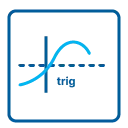
Channel Trigger
The data acquisition boards offer a wide variety of trigger modes. Besides the standard signal checking for level and edge as known from oscilloscopes it's also possible to define a window trigger. Trigger conditions can be combined with logical conjunctions like OR to adopt to different application scenarios.
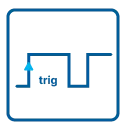
External Trigger
All boards can be triggered using an external TTL signal. It's possible to use positive or negative edge also in combination with a programmable pulse width. An internally recognized trigger event can - when activated by software - be routed to the trigger connector to start external instruments.
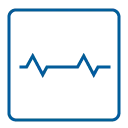
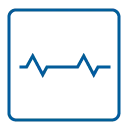
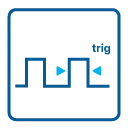
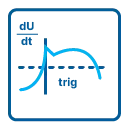
Spike Trigger
The trigger event is a slope inside the signal that is larger (or even smaller) than a programmed slope. Internally the difference of two adjacent samples is calculated and then compared to the programmed trigger level. This trigger mode allows the detection of signal distortions as needed for power line monitoring.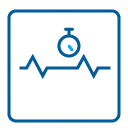
Timestamp
The timestamp option writes the time positions of the trigger events in an extra memory. The timestamps are relative to the start of recording, a defined zero time, externally synchronized to a radio clock, or a GPS receiver. With this option acquisitions of systems on different locations can be set in a precise time relation.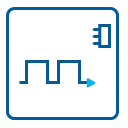
External Clock
Using a dedicated connector a sampling clock can be fed in from an external system. It's also possible to output the internally used sampling clock to synchronize external equipment to this clock.
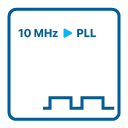
High Precision PLL
The internal sampling clock of the card is generated using a high precision PLL. This powerful device allows to select the sampling rate with a fine step size making it possible to perfectly adopt to different measurement tasks. Most other cards on the market only allow the setup of fixed sampling rates like 100 MS/s, 50 MS/s, 25 MS/s, 10 MS/s, ... without any possibility to set the sampling rate to any value in between.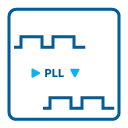
Reference Clock
The option to use a precise external reference clock (normally 10 MHz) is necessary to synchronize the board for high-quality measurements with external equipment (like a signal source). It's also possible to enhance the quality of the sampling clock in this way. The driver automatically generates the requested sampling clock from the fed in reference clock.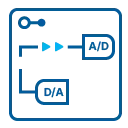
On-board Calibration
The on-board calibration can be run on user request and calibrates the amplifier against a dedicated internal high precision calibration source. After this calibration data is stored permanently in an on-board EEPROM and is automatically used for further acquisitions.
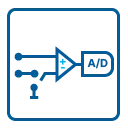
Differential Inputs
With a simple software command the inputs can individually be switched from single-ended (in relation to ground) to differential, without loosing any inputs. When the inputs are used in differential mode the A/D converter measures the difference between two lines with relation to system ground.
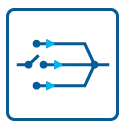
Programmable Input Amplifiers
The analog inputs can be adapted to real world signals using individual settings for each channel. A large number of different input ranges and a programmable input offset allow to adopt perfectly to the real world signals.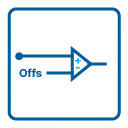
Programmable Input Offset
Most of the Spectrum A/D cards offer a user programmable signal offset opening the Spectrum boards to a wide variety of setups. The signal offset at least covers a range of +/-100 % of the currently selected input range making unipolar measurements with the card possible. Besides this the input range offset can be programmed individually allowing a perfect match of the A/D card section to the real world signal.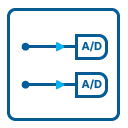

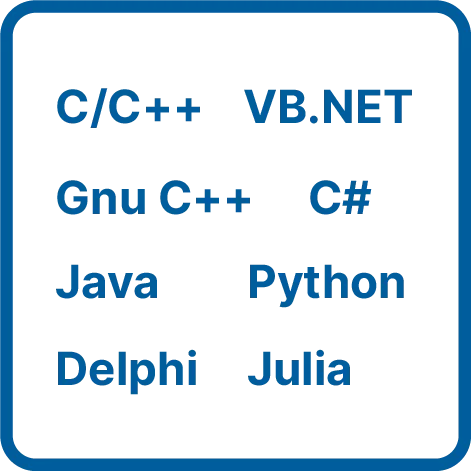

Remote Access
The digitizerNETBOX can be remotely accessed from any current Windows (starting with Windows XP) 32 bit or 64 bit system or Linux (starting with Kernel 2.6) 32 bit or 64 bit system by Ethernet. The remote access is done in the very exact programming like a locally installed product allowing to use any of the supported software packages.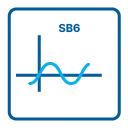
| Product | Channels | Max. Samplerate | Max. Bandwidth |
|---|---|---|---|
| DN2.462-04 | 4 | 200 KS/s | 100 KHz |
| DN2.462-08 | 8 | 200 KS/s | 100 KHz |
| DN2.462-16 | 16 | 200 KS/s | 100 KHz |
| DN2.464-04 | 4 | 1 MS/s | 500 KHz |
| DN2.464-08 | 8 | 1 MS/s | 500 KHz |
| DN2.464-16 | 16 | 1 MS/s | 500 KHz |
| DN2.465-08 | 8 | 3 MS/s | 1.50 MHz |
| DN2.465-16 | 16 | 3 MS/s | 1.50 MHz |
| On different platforms | Bus | Max. Bus Transfer speed |
|---|---|---|
| M2i.4651 | PCI-X | 245 MByte/s |
| M2i.4651-Exp | PCI Express x1 | 160 MByte/s |
| MC.4651 | CompactPCI | 100 MByte/s |
| MX.4651 | PXI | 100 MByte/s |
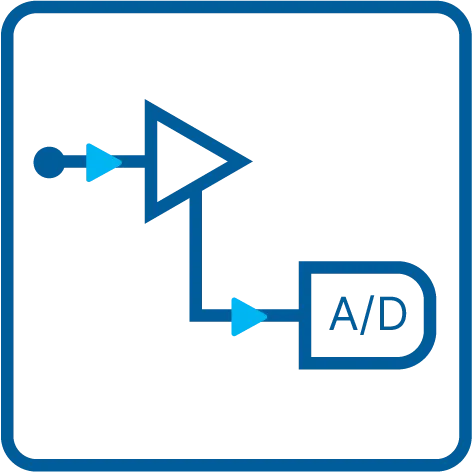
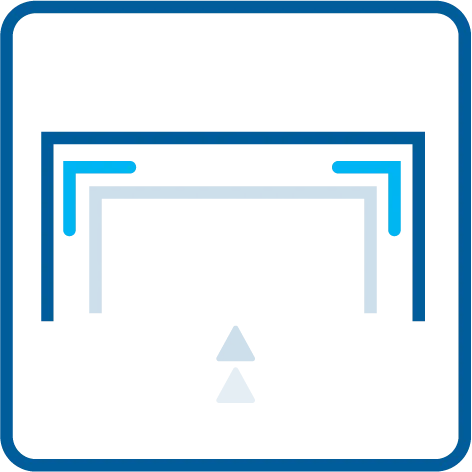
Documents
Data sheet of digitizerNETBOX DN2.46x |
21.02.2022 | 965 K | ||
Manual of digitizerNETBOX DN2.46x and DN6.46x series |
21.02.2022 | 7 M | ||
Short Manual for IVI Driver |
21.02.2022 | 532 K | ||
Data sheet of SBench 6 |
15.01.2024 | 999 K | ||
Manual for MATLAB driver M2p/M4i/M4x/M5i/M2i/M3i/DN2/DN6 |
13.12.2023 | 1 M | ||
Manual for LabVIEW drivers for M2i/DN2 |
21.02.2022 | 2 M | ||
Manual for SBench 6 |
21.02.2022 | 7 M |
WINDOWS DRIVER + SOFTWARE
M2p/M4i/M4x/M5i/M2i/M3i/DN2/DN6 driver for Windows 7, 8, 10, 11 (32/64 bit) |
7.00 | 23.02.2024 | 5 M | |
C/C++ driver header and library files |
7.00 | 23.02.2024 | 43 K | |
Spectrum Control Center (32-bit) / Windows 7, 8, 10 |
2.35 | 23.02.2024 | 22 M | |
Spectrum Control Center (64-bit) / Windows 7, 8, 10, 11 |
2.35 | 23.02.2024 | 25 M | |
Spectrum Control Center - last Version for Windows XP |
1.74 | 21.02.2022 | 8 M | |
SBench 6 (32-bit) Installer / Windows 7, 8, 10 |
6.5.07 | 23.02.2024 | 36 M | |
SBench 6 (64-bit) Installer / Windows 7, 8, 10, 11 |
6.5.07 | 23.02.2024 | 39 M | |
SBench6 - last Version for Windows XP |
6.3.5 | 21.02.2022 | 41 M | |
IVI Driver for IVI Digitizer class (32 bit) |
23.02.2024 | 3 M | ||
IVI Driver for IVI Scope class (32 bit) |
23.02.2024 | 3 M | ||
M2i/M2p/M3i/M4i/M4x/M5i/DN2/DN6 LabView driver installer |
23.02.2024 | 19 M | ||
M2p/M4i/M4x/M5i/M2i/M3i/DN2/DN6 Matlab driver + examples installer |
23.02.2024 | 7 M | ||
Windows Examples (C/C++, .NET, Delphi, Java, Python, Julia ...) |
7.00 | 23.02.2024 | 2 M |
LINUX DRIVER + SOFTWARE
Driver libraries (no Kernel) for Linux 32 bit and 64 bit |
7.00 | 23.02.2024 | 9 M | |
Spectrum Control Center |
2.35 | 07.03.2024 | 57 M | |
SBench 6 Linux 32 (.rpm) |
6.5.07 | 23.02.2024 | 26 M | |
SBench 6 Linux 64 (.rpm) |
6.5.07 | 23.02.2024 | 26 M | |
SBench 6 Linux 32 (.deb) |
6.5.07 | 23.02.2024 | 23 M | |
SBench 6 Linux 64 (.deb) |
6.5.07 | 23.02.2024 | 22 M | |
SBench6 Jetson (.deb) |
6.5.07 | 23.02.2024 | 8 M | |
Drivers + examples for MATLAB for Linux (DEB + RPM) |
23.02.2024 | 183 K | ||
Linux Examples (C/C++, Python, Julia ...) |
7.00 | 23.02.2024 | 556 K |
Firmware
DN2 Standard Firmware V27 (update from versions V7-V26 to V27) |
V27 | 21.02.2022 | 52 M | |
DN2 Standard Firmware V7 (update from versions V1-V6 to V7) |
V7 | 21.02.2022 | 11 M | |
DN2/DN6 Standard Firmware (install V27 first for updates prior to V27) |
V81 | 23.02.2024 | 34 M |
Case Studies
| CS Automotive Data Recorder | Case Automotive Data Study Recorder and Playback Solution |
21.02.2022 | 278 K |
Product Notes
| General Digitizer Introduction | General Introduction to Waveform Digitizers |
21.02.2022 | 587 K | |
| High-Res High BW Digitizers | Advantages of High Resolution in High Bandwidth Digitizers |
21.02.2022 | 2 M | |
| Digitizer Acquisition Modes | Using modular Digitizer Acquisition Modes |
21.02.2022 | 3 M | |
| Digitizer Front-End | Proper Use of Digitizer Front-End Signal Conditioning |
21.02.2022 | 3 M | |
| Trigger and Sync | Trigger, Clock and Synchronization Details at high-speed Digitizers |
21.02.2022 | 1 M | |
| Digitizer Software Integration | Software Support for Modular Digitizers |
21.02.2022 | 724 K | |
| LXI based Digitizers | LXI based Multi-channel Digitizer Instrument |
21.02.2022 | 739 K | |
| SBench 6 Introduction | SBench 6 - Data Acquisition and Analysis of Digitizer Data |
21.02.2022 | 1 M |
Application Notes
| Ultrasonic Applications | Using Digitizers in Ultrasonic Applications |
21.02.2022 | 617 K | |
| Signal Processing Tools | Using Signal Processing Tools to enhance Digitizer Data |
21.02.2022 | 1 M | |
| Mechanical Measurements | Mechanical Measurements Using Digitizers |
21.02.2022 | 1 M | |
| Power Measurements | Power Measurements Using Modular Digitizers |
21.02.2022 | 1 M | |
| Using Probes & Sensors | Using Probes and Sensors with Modular Digitizers |
21.02.2022 | 858 K | |
| Digitizers as Oscilloscope | Using a Digitizer as Oscilloscope |
21.02.2022 | 845 K | |
| Solving Data Transfer Bottlenecks on Digitizers | Solving Data Transfer Bottlenecks on Digitizers |
21.02.2022 | 2 M | |
| Teaming AWG with Digitizer | Teaming an Arbitrary Waveform Generator with a Modular Digitizer |
21.02.2022 | 919 K | |
| Common Digitizer Setup Problems | Application Note: Common Digitizer Setup Problems to avoid |
21.02.2022 | 1 M | |
| Mechanical Measurements D | Mechanische Messungen mit modularen Digitizern |
21.02.2022 | 1 M | |
| AN Vehicular Testing with Modular Instruments | Application Note: Vehicular Testing with Modular Instruments |
21.02.2022 | 1 M | |
| AN Testing Power Supplies | Application Note: Testing Power Supplies using Modular Digitizers |
21.02.2022 | 898 K | |
| AN Amplitude Resolution | Application Note: The Amplitude Resolution of Digitizers and how it affects Measurements |
21.02.2022 | 555 K |
